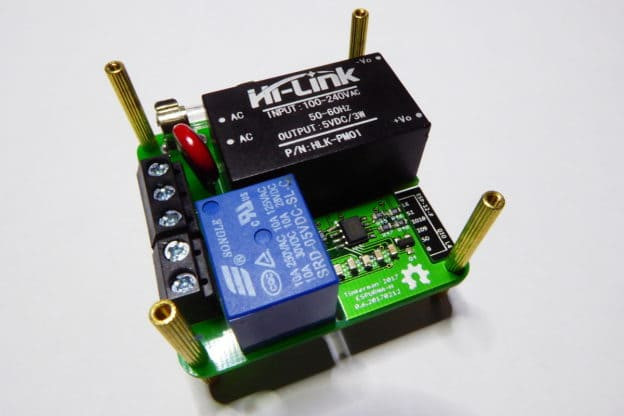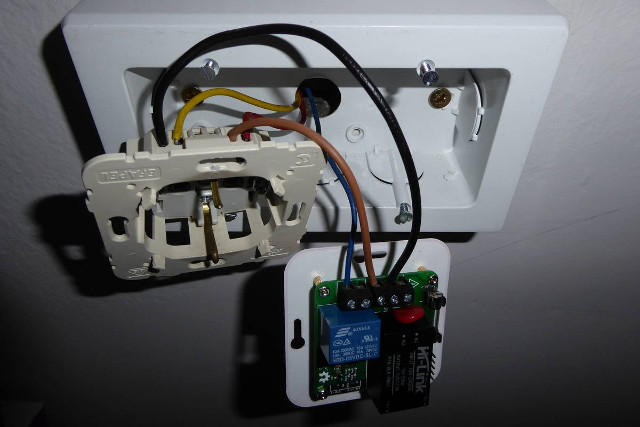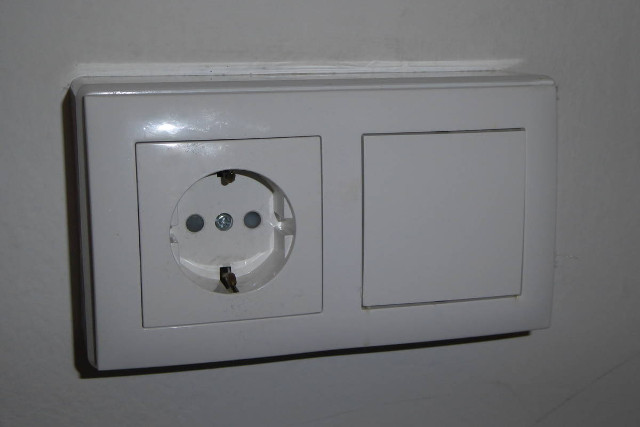ESPurna is an open source firmware for ESP8266 based wireless switch as such Sonoff POW, which I’ve been personally using to monitor my office’s power consumption. The developer, Xose Pérez (aka tinkerman), has now developed his own hardware with ESPurna-H board, as existing wireless switches with power monitoring functions would not fit into a gang box.
 ESPurna-H board specifications:
ESPurna-H board specifications:
- WiFi Module – ESP12 with Espressif ESP8266 WiSoC
- Relay – Songle SRD-05VDC-SL-C 10A relay with NO and NC connection
- Power Monitoring – HLW8012 chip as found in Sonoff POW
- Expansion – 2x 5-pin header with the programming GPIOs, and two connections for external button and LEDs
- Misc – Reset button
- Power Supply
- Input – 100 ~ 240V AC
- Output – 5V up to 600 mA via Hi-Link HLK-PM01
- Safety – Optical isolation between the logic circuit and the relay circuit
- Dimensions – 50x50x20mm
Xose designed the board with Eagle 8.0 and released the schematics, PCB layout, BoM and other hardware design files under the Creative Commons Attribution-ShareAlike 3.0 Unported License (CC-BY-SA 3.0). You’ll find the files on github.

The board is not for sale, but you could purchase the PCB on OSH Park, purchase the components separately, and finally do the soldering yourself. Since this is a hobby project, not specific safety testing has been done, and you’d better understand what you are doing since the board is meant to be connected to the mains. Even companies do it wrong from time to time. If there’s a design flaw with the board it could overheat melting the plastic around, and in the worst case even start a fire.
 Xose completed the setup with a capacitive touch switch attached to the cover, in order to turn on and off the light, and the final results above looks quite neat.
Xose completed the setup with a capacitive touch switch attached to the cover, in order to turn on and off the light, and the final results above looks quite neat.

Jean-Luc started CNX Software in 2010 as a part-time endeavor, before quitting his job as a software engineering manager, and starting to write daily news, and reviews full time later in 2011.
Support CNX Software! Donate via cryptocurrencies, become a Patron on Patreon, or purchase goods on Amazon or Aliexpress




Wow, they use really thin wires there in Spain for the 220-240V!
Nice board, hopefully itead will take it over, but then also for the TH16 and with connector for RTC (altough I seem the only one who wants a RTC on these things…)
That would be highly illegal in most of Europe, as you would need an electrician to install something like that and it would have to be certified to be connected out to mains power.
As long as its shipped from a china/hk warehouse… Then you are the importer, not the seller…
It has nothing to do with where it’s shipped from, if there’s a fault, you’re solely responsible and might have to pay millions if say a house burns down, as no insurance will cover it.
Someone needs to productize it in the US. UL testing isn’t cheap, but the design looks good and shouldn’t need much to be made salable here.
The only thing that I am not sure of is whether tinkerman wants his name on it in the case there is a fire and liability issues, even with UL certification. That is a whole new corner of the law that I’ve not seen a precedent for. And you know what they say about pioneers, they end up with their butts shot full of arrows.
I’d love to have such a device. The only thing I didn’t see any words about that I’d want is whether it could handle a circuit such as a refrigerator, or freezer, and what it does with reactive power. Since it uses a shunt with the HLW8012 looking across it for the current or voltage, it also means the power surge for motor start is thru the device, which isn’t a great idea, even if the average power was within spec.
But for light bulbs and things with low reactive power maybe you’ll get away with it.
When you think you’ve saw all possible RF atrocities here comes a PCB antenna right next to the mains switch mode supply. But hey he left a board cutout so that’s all good, right..
This would never pass any certification.
@JM
Seen the Itead boards already?